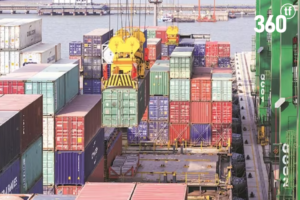Trade is one of the most important drivers of economic growth. However, Africa as a continent is still not entirely capturing the growth-enhancing benefits of international commerce. Although its population has more than tripled over the last five decades to account for around 17% of the world’s population, Africa’s share of global trade has decreased steadily over the same period from 4.4% to 3%.
Trade Finance plays a principal role in the growth of trade globally. The deficit of trade finance is a persistent issue that the current pandemic is likely to aggravate. Furthermore, African trade accounts for only 3% of world trade. Regulatory challenges have emerged as a significant drag on trade finance in Africa with 15% of banks listing regulations as the main constraint to expanding trade finance supply.
However, the unmet demand in trade finance has declined significantly from its peak of USD 120 billion at the beginning of the 2010 decade to USD 81 Billion by the end of the epoch. The global trade finance gap is estimated to be USD 1.5 trillion annually with Africa representing 5.5% of the gap. The global response from key players in the industry including Development Financial Institutions (DFIs) undoubtedly contributed to this decline. DFIs are increasingly playing an active role in African trade by providing facilities for short-term working capital lending and credit guarantees to SMEs. An average of 60% of banks in Africa that engage in trade finance activities receive some form of DFI Support.
Trade Finance remains a popular activity among banks in Africa, but the participation rate continues to decrease declining by 16% to 71% in recent years. Several factors influence bank participation in trade finance transactions. At the country level, these include access to foreign exchange, liquidity, competition, capital requirements, and interest rates which impact the bankability to participate in trade finance activities.
Roughly 60% of trade finance assets of banks are unfunded transactions such as letters of credit. On average, trade finance assets accounted for 14% of total bank assets in Africa in the previous decade.
All letters of credit issued by African banks require confirmation from large global banks. As global banks pull out of markets that are too risky, they leave many African banks at risk of not being able to conduct trade in foreign currency compounded by reduced confirmation lines on African Banks. Based on SWIFT data analysis, the number of correspondent banking relationships involving US Dollar transactions decreased by about 25% over the last decade.
Digitization is the plug to fill the gap of trade finance, especially confirmation requirements for LCs issued by the 400+ African Banks universe. There has been some headway in this space, but more work needs to be done with more support from international trade organizations and financial institutions. Only a handful of FinTech companies are focused on digitizing various aspects of trade financing. 360tffor instance brings the trading world closer by connecting importers and exporters to global banks for fulfilling LC confirmation and financing requirements. On the 360tf platform, LCs are confirmed by banks located in large financial centres providing risk mitigation to importers and exporters.
Recently ICC launched ICC Trade Now, a suite of digital products and services, to tackle the global trade finance gap in all its breadth and complexity.
ICC Trade Now offers a portfolio of solutions that address various facets of the trade finance gap. SMEs can select solution providers that are most aligned with their needs while a wide array of financiers will be able to leverage ICC Trade Now to service SMEs profitably. Three digital solutions – ICC TRADECOMM, TradeFlow Capital, and FQX – have been announced under the ICC Trade Now campaign with more solutions expected to be added in 2021.
African trade is significantly underserved by banks. For the period 2011-19, banks intermediated about 40% of total African trade, compared to the global average of 80%. While 17% of total African trade is intra-African, the share of trade finance dedicated to intra-African trade is 18%. However, the contribution of trade finance to bank earnings has decreased from 17% to about 10% in recent years due to higher processing fees, failing trade volume, and additional KYC and AML requirements.
Trade finance transactions are generally asset-backed, self-liquating, and short-term in nature. They remain relatively low-risk activities. While average default rates on trade finance activities by African banks are lower than overall bank NPLs in Africa, they are far higher than the default rate on global trade finance activities. Although the SME risk profile has improved, the SME trade Finance application rejection rate continues to increase.
Addressing the key challenges of the Trade Finance gap will require a concerted effort between various players in the industry including Trade FinTech, multilateral organizations, international and national regulators, and commercial banks. A good starting point is to raise awareness regarding challenges imposed by new KYC/AML requirements on banks in the trade finance sector. As economies move to implement Basel III regulations and stringent anti-money laundering measures, banks have to set aside more risk capital for foreign transactions, including for trade finance assets as well as invest more in vetting new clients.
Multilateral development banks now play a more active role in the trade finance industry, but research indicates that support is skewed in favour of banks in West and Southern Africa because these regions have the highest gap. Therefore, it is immensely important to address these geographic disparities to boost trade and reduce sub-regional income disparities across the continent. More should be done to increase support for local banks that participate in trade finance in Africa overall.
In the coming years, African trade will experience new challenges and opportunities. The introduction of the new African Continental Free Trade Area (AFCFTA) is expected to eliminate significant barriers to intra-African trade and create a large market for firms across the region. At the same time, the ongoing global health crisis is impacting global supply chains and regional trade with the rest of the world, while limiting the availability of dollar liquidity to support trade. Thus, once the crisis recedes, the need for financing to reenergize regional trade will be greater and more urgent. Concrete and urgent steps to reduce the trade finance gap in Africa and address the challenges faced by the industry will be equally important.




